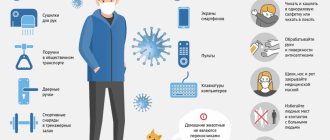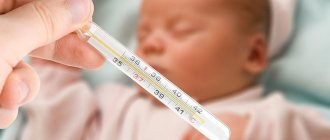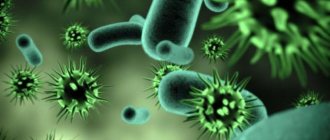Since childhood, we know that there is a normal temperature, and there is a “bad” one. Normal means a temperature of 36.6 degrees. Everything higher and lower indicates that something wrong is happening in the body.
The reasons for the increase in temperature can be quite innocent: for example, in women approximately in the middle of the cycle, when ovulation occurs. The thermometer readings may increase even after intense physical activity - this is normal. But sometimes the reasons are much more serious.
The first thing to do is to listen carefully to yourself and try to understand what else is bothering you besides the fever. The effectiveness of the treatment prescribed by the doctor will depend on how correctly you determine this. With a very high temperature (above 39 degrees), the condition can be very serious, and the best thing to do is to immediately call an ambulance. Intense fever can be accompanied by convulsions, short-term loss of consciousness, even delirium - in short, this is not a condition when it is enough to just lie down at home.
High temperature without symptoms - causes and treatment
Do you have a high fever without symptoms that cannot be cured? Do medications restore the indicator for a limited time? Are there any symptoms other than fever? You need a comprehensive examination of the body! High fever without symptoms in adults can be a sign of serious damage to organs and systems. A functional examination at the Altimed clinic will help determine the true cause of this process.
What temperature is considered elevated?
First, let's define the concepts. If you have 36.9 °C or even 37 °C, it is too early to talk about elevated temperature. Normal body temperature is not necessarily 36.6 °C. It varies within fairly wide limits.
Body temperature norms are considered normal: MedlinePlus Medical Encyclopedia range from 36.1 to 37.2 °C.
If the thermometer shows values above 37.2 °C, they speak of Fever fever. It is also elevated temperature, or simply temperature in the commonly used sense.
Most often this condition is caused by an infection. For example, viral - influenza or other common acute respiratory viral infections. In this case, in addition to fever, you will most likely find other signs of respiratory illness: sore throat, runny nose, headache.
However, it happens that there is a temperature, but there are no other symptoms - snot, nausea, rashes, lethargy, irritability. The reasons for this can be both harmless and deadly.
High temperature without symptoms - what is it?
A high fever without symptoms in adults causes some stupor. Especially if in general the person feels fine. If such a symptom appears, it is important to get comprehensive medical care. The cause of fever may be hidden in the inflammatory process, viral or bacterial damage to the body.
Possible provoking factors are:
- infection with coronavirus (in the first days of the disease, only an increase in temperature can be recorded);
- excessive bacterial load on the body;
- acute food allergy (the symptom of fever is rare, but such a condition is not excluded).
Changes in temperature indicators are accompanied by a number of reasons. In women, a similar phenomenon is associated with the phases of the menstrual cycle and is often recorded with hormonal disorders. A slight increase is observed in stressful situations, with adrenaline surges.
A temperature of 37 without symptoms is typical for the following conditions:
- weakened immunity;
- indolent infection;
- state after depression;
- venereal disease.
Elevated temperature without symptoms is often observed with heat stroke, cancer, systemic inflammatory processes in the body, infection, etc.
The hypothalamus is responsible for thermoregulation in the body; it works under the full control of the autonomic nervous and endocrine systems. If there is a malfunction on their part, a slight increase in temperature may be recorded. In any case, deviations from the norm indicate a problem in the body.
Thus, a temperature of 39 without symptoms in an adult may indicate the development of
- tonsillitis;
- pneumonia;
- kidney inflammation;
- rheumatism and even heart attack.
If the symptom does not resolve within a week and no other problems are noted, it is important to see a doctor. The doctor’s main task is to determine the true cause of the disorders and exclude serious pathologies.
Low-grade fever
Low-grade fever - between 37 and 38 degrees - would seem to be a less dangerous thing. However, it is often very difficult to bear, the person feels overwhelmed and exhausted. And the most unpleasant thing is that all this can continue for weeks.
Without a strong fever, in a “sluggish” mode, people with an impaired immune status, weakened people get sick - in this case, the body simply cannot adequately respond to the disease. Most often, a low temperature accompanies ARVI - after a cough and runny nose appear, the thermometer begins to show increasingly higher numbers, and the symptoms, of course, do not go away.
Other diseases that may be accompanied by low-grade fever and their symptoms:
- Exacerbations of chronic bronchitis (in this case, you will cough more than usual)
- Chronic sinusitis and sinusitis (headache, difficulty breathing through the nose)
- Asthma (cough, shortness of breath, shortness of breath)
- Pulmonary tuberculosis (unstoppable cough, possibly with blood in the sputum)
- Myocarditis (pain in the heart area)
- Chronic pyelonephritis (pain in the side, slight swelling)
- Inflammatory diseases of the genitourinary area - for example, cystitis (frequent and painful urination)
- Stomach and duodenal ulcers (abdominal pain after eating, blood in the stool)
When to contact Altimed MC
High temperature for no reason is the main indication for visiting the Altimed medical center. Innovative equipment combined with the high professionalism of doctors will help identify the disorder and develop an optimal treatment regimen.
If a symptom is detected in a child, you cannot hesitate! Get help right away! This action will identify the disorder at the initial stage of development and prevent serious complications.
How to normalize temperature
The first aid to a person with a high body temperature should be the air he breathes. The optimal parameters for the patient's respiratory system are flow temperatures from 18˚C to 22˚C and humidity from 55% to 65%. This is what is more important than any medicine. Air entering the lungs replaces hot carbon dioxide molecules with cool oxygen molecules. If the patient feels chills, he needs to be dressed warmly, but he should breathe only cool and moist air.
Before taking antipyretics, you can use rubbing with cool compresses, if the patient’s condition allows, that is, when there is no trembling in the body.
Among the medications, two safe antipyretics can be distinguished:
- ibuprofen;
- paracetamol.
These components are found in all medications advertised as remedies for cold symptoms. Both medicines can be found both in the form of tablets and in the form of suppositories, as well as syrups. Children find it more pleasant to take syrup. But when vomiting prevents a person from taking the medicine, it is better to use suppositories intended for insertion into the rectum.
You can combine drugs. If paracetamol does not help bring down the temperature, you can give ibuprofen. It is important to remember that repeated use of the same drug is permissible no earlier than an hour and a half later.
A child can be given a second antipyretic, provided that an hour has passed since taking the first dose and the temperature has not dropped one degree. In this case, the second dose should consist only of another active substance. In other words, if an hour has passed after taking paracetamol and the situation has not changed, you can give an ibuprofen-based medicine.
Diagnosis of high temperature without symptoms at Altimed MC
Diagnosis of fever without symptoms in an adult is carried out using modern devices. There are many reasons for the development of the current trait. In order to identify a weak point, it is important to conduct a full functional diagnosis. It is absolutely safe for patients of any age, and is freely used to examine the child’s body.
The main advantages of functional diagnostics:
- quick results;
- absence of pain and discomfort;
- absolute safety;
- high accuracy;
- determination of a pathological condition at an early stage of development;
- checking the functional state of all organs and systems.
This method has virtually no contraindications. It is not recommended to use the modern diagnostic method for pregnant women, people suffering from cancer, or mental disorders.
Fever varies:
- with the flow:
- acute (fever up to 2 weeks),
- subacute (up to 6 weeks),
- chronic (over 6 weeks).
- according to the degree of increase in the indicator:
- subfebrile (increase to +38.0 degrees)
- febrile (from +38.0 to +39.0 degrees),
- pyretic (from + 39.0 to +41.0 degrees),
- hyperpyretic (over +41.0 degrees).
- by type of temperature curve:
- constant (temperature fluctuations during the day do not exceed 1 degree).
- laxative (daily fluctuations up to 2 degrees),
- atypical (oscillations are chaotic, varied and irregular),
- debilitating (a combination of laxative and atypical fever with fluctuations during the day of more than 2-3 degrees),
- intermittent (a combination of short-term periods of increase and decrease in temperature to normal values),
- recurrent (alternating periods of temperature increase with periods of temperature normalization from 2 to 7 days).
According to the recommendation of the WHO (World Health Organization), antipyretic drugs are prescribed to children according to age:
- from birth to 2 months at a temperature of +38.0 degrees,
- children from 3 months to 24 months with a temperature of +38.5 degrees,
- children from 1 to 5 years old with a temperature of +39.0 degrees,
- children over 5 years old at + 39.5- +40.0 degrees.
How is high fever treated at Altimed MC?
Temperature 38 without symptoms in an adult is treated at home, using innovative devices of the Lanta Z or Lanta Zl series. Therapy is carried out using the “Antiviral” and “Antibacterial” therapy programs. The duration of exposure and the number of procedures are determined individually, depending on the general condition of the patient and the cause of the elevated temperature.
Therapy is also carried out using devices from the Helper Personal series. They are designed to prevent viral and bacterial load on the body. The average duration of treatment is 10 days, but it all depends on the accompanying symptoms and the general condition of the person. Just 30 minutes a day is required to eliminate the viral and bacterial causes of fever without symptoms.
When to see a doctor immediately
Fever itself is not a cause for alarm. But there are exceptions Fever - Symptoms and causes. Seek immediate medical attention if you have a fever without symptoms:
- exceeded 38 °C in an infant under three months or 38.9 °C in a 3-6 month old child;
- reached 38.9 °C and lasts longer than a day in a child under two years old;
- arose after the child was left for a long time in a car parked in the sun;
- stays with the child for more than three days;
- rose above 39.4 °C in an adult.
All this speaks of conditions that threaten health and even life.
If there are no danger signs, a fever without symptoms may indicate some changes in your lifestyle and may soon subside on its own. But it is not exactly.
Why choose Altimed MC for the treatment of high fever without symptoms
Treatment, if the temperature does not show signs of a cold, is carried out at the Altimed Medical Center. Why is it important to contact us? The main advantages are:
- non-invasive effect on the body (without pain and discomfort);
- Individual approach to each client;
- innovative technical equipment;
- effective treatment plan;
- affordable price range.
From us you can purchase devices for treatment at home. For additional information, please contact the indicated phone numbers.
In what cases should you call an ambulance if your child has a fever?
Any of the symptoms listed below may occur suddenly, even if the fever was not previously accompanied by any known illness. The appearance of one or more of the following signs is a reason to call an ambulance.
Signs of dehydration appeared. The baby began to go to the toilet less often, his urine has darkened, and symptoms such as weakness, lethargy, and lack of tears when crying are observed.
There is confusion. The child does not respond to speech addressed to him, cannot concentrate, his consciousness is impaired, and delirium has appeared.
There is no antipyretic effect. It is not possible to bring down a high temperature even for a short time with the help of medications.
Breathing disturbances are observed. The baby's breathing becomes very frequent or, conversely, rare, hoarse, whistling.
MAXICOLD® for CHILDREN at high temperatures
MAXICOLD® for CHILDREN is a modern antipyretic drug, the active component of which is ibuprofen. The drug helps reduce high fever for a long time (up to 8 hours2,3*), thereby easing the well-being of a sick baby. MAXICOLD® for CHILDREN is a suspension with strawberry or orange flavor, which is convenient to dose using a measuring spoon (included in the package) and simply give to the child. The product does not contain sugar, alcohol or artificial colors. MAXICOLD® for CHILDREN in the dosage recommended by age can be used as an antipyretic for 3 days. If you need to take the drug for longer, you should consult your doctor.
* for the active substance ibuprofen 1 For children over 3 months in accordance with the instructions for medical use of the drug MAXICOLD® for CHILDREN and after consultation with a doctor. 2 Ushkalova, E.A. Safety profile of analgesics-antipyretics in pediatrics / Russian Medical Journal. -2014.- T. 22. -No. 21.- P. 1526-1529. 3 Morozova T.E., Rykova S.M., Yudina I.Yu. Ibuprofen in children: profile of effectiveness and safety: “Pediatrician Practice”, September 2014, p. 18-22.
Causes
LNG can be caused by infectious diseases, the development of an inflammatory or malignant process, or systemic connective tissue diseases.
The most common reasons:
- infectious diseases - malaria, tuberculosis, aspergillosis, herpes, borreliosis, tick-borne encephalitis, abdominal-pelvic abscesses, prostate abscess, cholecystitis, dental infections, endocarditis, osteomyelitis, sinusitis, cytomegalovirus, Epstein-Barr virus, HIV, genitourinary infections, opportunistic infections ;
- autoimmune diseases - inflammatory bowel disease, rheumatoid arthritis, adult Still's disease, polymyalgia rheumatica, Reiter's syndrome, vasculitis, systemic lupus erythematosus, rheumatic fever;
- malignant tumors - renal cell carcinoma, hepatoma, colon cancer, pancreatic cancer, sarcomas, lymphomas, chronic leukemia, metastatic cancer.
Other reasons include:
- drug-induced fever (hypersensitivity reaction to certain medications);
- hepatitis (granulomatous, lupus, alcoholic);
- complications of liver cirrhosis;
- deep vein thrombosis;
- gout;
- Behçet's disease;
- Felty's syndrome;
- sarcoidosis;
- thyroiditis, Crohn's disease, familial periodic fever, cyclic neutropenia (rare).











